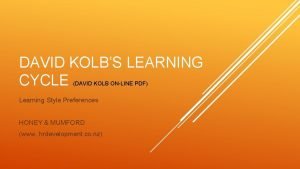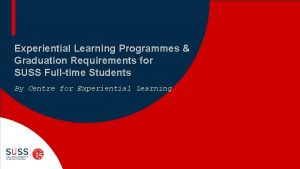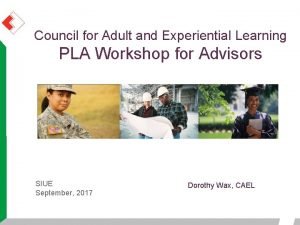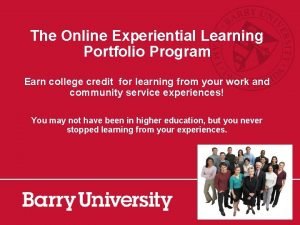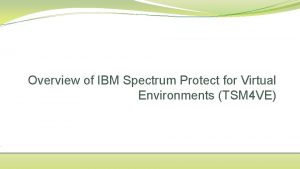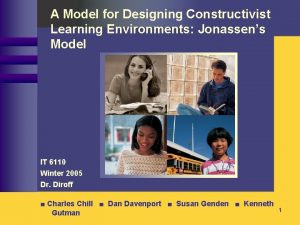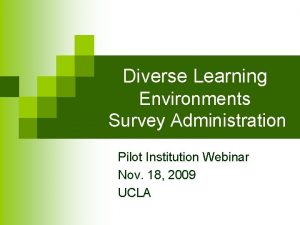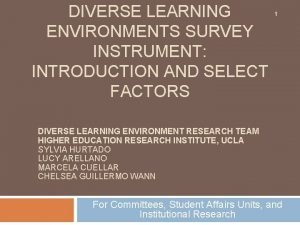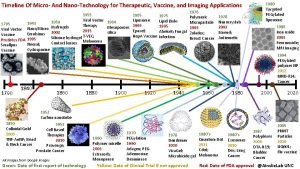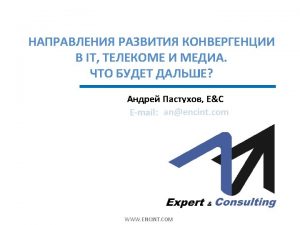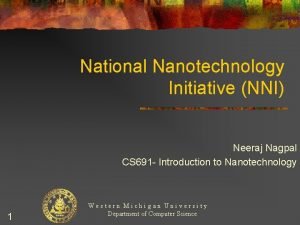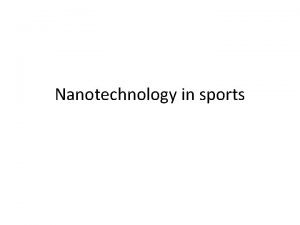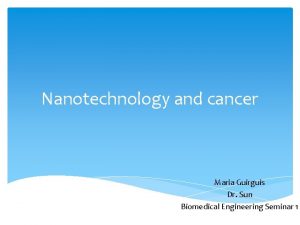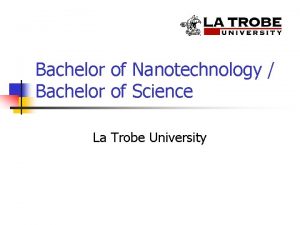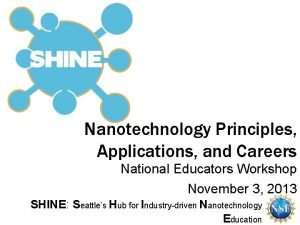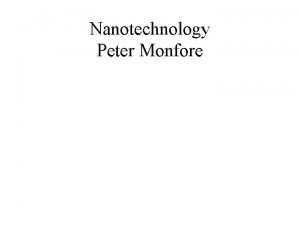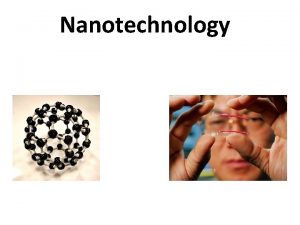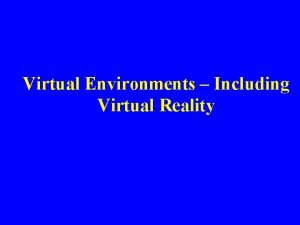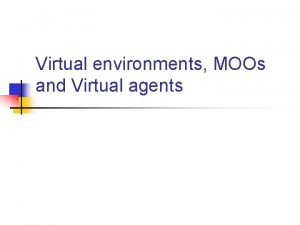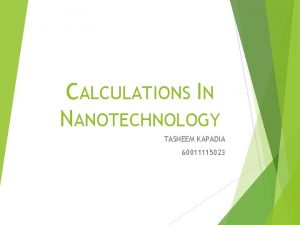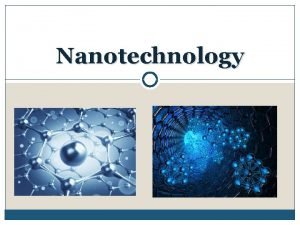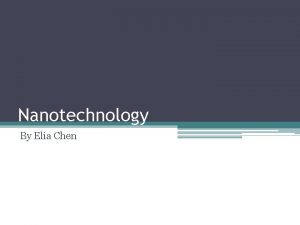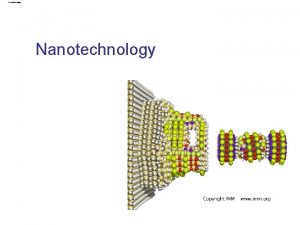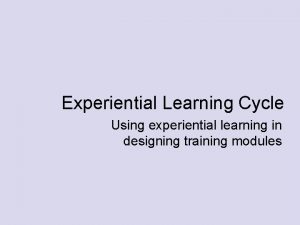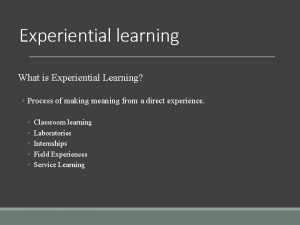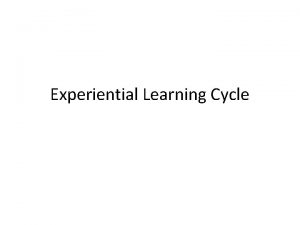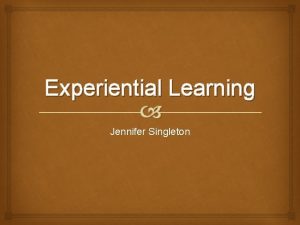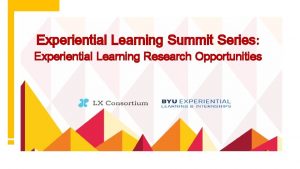Multimedia learning environments for virtual experiential engineering Nanotechnology
















- Slides: 16

Multimedia learning environments for virtual experiential engineering (Nanotechnology) Frank Fisher 1 Hong Man 2 Ling Chen 2 Vinod Challa 1, Gaurav Mago 1 1 Department of Mechanical Engineering 2 Department of Electrical and Computer Engineering Stevens Institute of Technology Hoboken, NJ 07030 Stevens - New Jersey Community College Strategic Partnership September 27, 2005 Department of Mechanical Engineering Stevens Institute of Technology

Motivation • Consider a standard S-curve “adaptation of technology” curve and the use of computer technology in education • How will students learn is 10 years? In 20 years? In 50 years? Impact • Leveraging multimedia capabilities for educational design Time • Email • Powerpoint • Webpages • Course software • Course specific applets • drilling modules • Course administration - drilling - student learning Department of Mechanical Engineering Stevens Institute of Technology

Use of multimedia • Case-based learning used in other pre-professional fields (law, medicine, education) • multimedia technology now provides the opportunity to bring the practice of authentic engineering into the classroom! Department of Mechanical Engineering Stevens Institute of Technology

Introduction • Design, develop, and demonstrate a flexible multimedia-based environment based on the video documentation of authentic engineering practice to be incorporated into the undergraduate • Potential learning environments enabled via multimedia technology:

VREUN • Virtual Research Experiences in Nanotechnology • New NSF-funded project (September 2005) • 6 Nanotechnology faculty at Stevens, 1 ECE faculty at Stevens (multimedia), CIESE

VREUN Goal: Introduce concepts of nanotechnology and tie into core engineering fundamentals within the context faculty research couched in the spirit of Technogenesis

Learning environment interface (version 0. 1) q Frame-based environment Much smaller constant header Dynamic sequencing More interesting video! Text box video-sensitive text/images/links related to discussion within clip Talking head Module Navigation (non-linear progression) Department of Mechanical Engineering Stevens Institute of Technology Email a question to Prof. Fisher Help?

Virtual research experiences q More detailed information (content) than in lab tours q Connect research project with larger picture q Approach of the research projects; uncertainty q Focus on u-grad participation q Window into research Vibration based Micropower Generation Importance, Background Work environment q Comparison of Different Techniques & choosing Novel Design, Modeling, Justification Tie research to education Proto-Type fabrication & Testing, as proof of Concept Realization of process flow for MEMS scale fabrication q Techniques, Issues involved. Possible Issues that could be encountered, How to deal Evaluation will be critical: q Usability, scaffolding, etc Microfabrication & Testing of the device. Packaging & re-testing of the device. Department of Mechanical Engineering Stevens Institute of Technology

Advantages of a multimedia based format • Video documentation provides the motivation and indexing for students to learn engineering “content” material • Video supplemented with content information (text, audio, etc) • Provides students: 1. 2. 3. 4. Window into practice of engineering See type of ill-defined problems common in practice of engineering Framework of how engineering education relatesto real-world engineering (Why am I learning this? ) Benefits recognized of co-ops, internships, etc (can we package and incorporate into curriculum) Department of Mechanical Engineering Stevens Institute of Technology

End with a story… • Brooke, starting at Stevens in Fall, in lab for 2 weeks • Explanation of my research… – What is a composite? – What is modulus? - What is strength? – What is a nanometer? – Why are carbon nanotubes so promising? – What could they be used for? …. - What is a polymer? Department of Mechanical Engineering Stevens Institute of Technology

Extra slides Department of Mechanical Engineering Stevens Institute of Technology

Work in progress • Objectives: – Design the format/layout for the learning environment – Design author interface mechanism (Web. CT) for adding material (author mode) – Develop modules based on two Fisher research projects – Develop additional multimedia lab tours • Interface mechanism: – Straightforward to upload video, text, audio, etc and edit module – Dynamic website so that both module and TOC updated – CD vs. online distribution; browser compatibility; OS (Windows vs Mac) – Database design, communication protocols, and content organization • Research Project documentation – Audio/video collection of sufficient quality – Multimedia editing (video, audio) – Organization – Clarity of information and level-appropriateness

Multimedia interface - front page q Work-in-progress q Placeholders for now; better content later Author mode login Front page introduction/navigation Continue to labs Department of Mechanical Engineering Stevens Institute of Technology

Environment main page q Main page for grouping of modules: “virtual lab tours”, VREUN, etc Virtual lab tours currently available: ME CBME -Nanomechanics/materials (Fisher) - Lab 1 (Prof) -Lab 2 (Prof) - Lab 2 (Prof) ECE -Multimedia Lab (Man) -Lab 2 (Prof) Select lab from above menu Department of Mechanical Engineering Stevens Institute of Technology

Multimedia learning environments for virtual experiential engineering and incorporation into the undergraduate curriculum Frank Fisher, ME Hong Man, ECE RIEE meeting May 27, 2005 Department of Mechanical Engineering Stevens Institute of Technology

Introduction • design, develop, and demonstrate a flexible multimediabased learning environment • facilitate the deployment of modules based on the video documentation of engineering practice to be incorporated into the undergraduate curriculum • Virtual Co-op, Virtual Internship, Virtual REU Department of Mechanical Engineering Stevens Institute of Technology
 Esa multimedia.esa.int./multimedia/virtual-tour-iss
Esa multimedia.esa.int./multimedia/virtual-tour-iss David kolb pdf
David kolb pdf Portfolium suss
Portfolium suss Council for adult and experiential learning
Council for adult and experiential learning Experiential learning portfolio
Experiential learning portfolio Include.vmsnapshotattempts
Include.vmsnapshotattempts Designing constructivist learning environments
Designing constructivist learning environments Diverse learning environments survey
Diverse learning environments survey Diverse learning environments survey
Diverse learning environments survey Timeline of nanotechnology
Timeline of nanotechnology What is nanotechnology
What is nanotechnology Nanotechnology for kids
Nanotechnology for kids Nanotechnology in golf
Nanotechnology in golf Nanotechnology fact or myth articles
Nanotechnology fact or myth articles Disadvantages of nanotechnology
Disadvantages of nanotechnology Disadvantage of nanotechnology
Disadvantage of nanotechnology Nanotechnology
Nanotechnology

